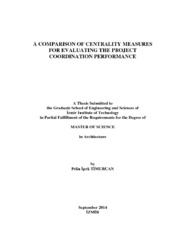Please use this identifier to cite or link to this item:
https://hdl.handle.net/11147/4303Full metadata record
| DC Field | Value | Language |
|---|---|---|
| dc.contributor.advisor | Doğan, Sevgi Zeynep | - |
| dc.contributor.author | Timurcan, Pelin İpek | - |
| dc.date.accessioned | 2015-05-20T11:07:46Z | - |
| dc.date.available | 2015-05-20T11:07:46Z | - |
| dc.date.issued | 2014-09 | - |
| dc.identifier.citation | Timurcan, P. İ. (2014). A comparison of centrality measures for evaluating the project coordination performance. Unpublished master's thesis, İzmir Institute of Technology, İzmir, Turkey | en_US |
| dc.identifier.uri | http://hdl.handle.net/11147/4303 | - |
| dc.description | Thesis (Master)--İzmir Institute of Technology, Architecture, İzmir, 2014 | en_US |
| dc.description | Full text release delayed at author's request until 2017.10.13 | en_US |
| dc.description | Includes bibliographical references (leaves: 97-103) | en_US |
| dc.description | Text in English; Abstract: Turkish and English | en_US |
| dc.description | xv, 135 leaves | en_US |
| dc.description.abstract | Evaluation of coordination performance in a project network requires reliable measures and monitoring methods for effective management. Recent literature includes studies addressing the relationship between coordinative activity and the configuration of communication networks. In these works, the role of network centrality is investigated through the basic standard centrality measures of degree, betweenness and closeness. Current social network analysis research emphasizes new formulations of centrality measures for robust structural analysis of project networks. This study presents a novel approach for measuring network centrality using the concept of information centrality. It is based on the idea that all paths carry information. The significance of information centrality values for the actors in two major projects of Enron Corporation is investigated. There are three major findings from these analyses. First finding suggests that highly centralized actors show more coordination. Second finding suggests that information centrality is the most potent predictor for coordination in undirected networks. Third finding is that out-centrality measures are better predictors for coordination performance in directed networks. The implications of these findings have potentials for assessing the coordination performance in construction management research, and it is promising for the structural analysis of project communication networks. | en_US |
| dc.language.iso | en | en_US |
| dc.publisher | Izmir Institute of Technology | en_US |
| dc.rights | info:eu-repo/semantics/openAccess | en_US |
| dc.subject | Coordination performance | en_US |
| dc.subject | Network centrality | en_US |
| dc.subject | Centrality measures | en_US |
| dc.title | A Comparison of Centrality Measures for Evaluating the Project Coordination Performance | en_US |
| dc.title.alternative | Proje Koordinasyon Başarımının Değerlendirilmesi için Merkezilik Ölçümlerinin Bir Karşılaştırılması | en_US |
| dc.type | Master Thesis | en_US |
| dc.institutionauthor | Timurcan, Pelin İpek | - |
| dc.department | Thesis (Master)--İzmir Institute of Technology, Architecture | en_US |
| dc.relation.publicationcategory | Tez | en_US |
| dc.identifier.wosquality | N/A | - |
| dc.identifier.scopusquality | N/A | - |
| item.languageiso639-1 | en | - |
| item.grantfulltext | open | - |
| item.fulltext | With Fulltext | - |
| item.openairecristype | http://purl.org/coar/resource_type/c_18cf | - |
| item.openairetype | Master Thesis | - |
| item.cerifentitytype | Publications | - |
| Appears in Collections: | Master Degree / Yüksek Lisans Tezleri | |
Files in This Item:
| File | Description | Size | Format | |
|---|---|---|---|---|
| T001335.pdf | MasterThesis | 2.36 MB | Adobe PDF |  View/Open |
CORE Recommender
Page view(s)
288
checked on Jun 10, 2025
Download(s)
120
checked on Jun 10, 2025
Google ScholarTM
Check
Items in GCRIS Repository are protected by copyright, with all rights reserved, unless otherwise indicated.